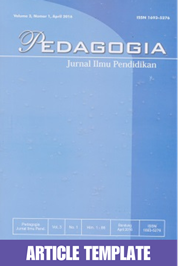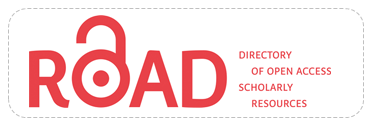Strategy to Overcome Early Childhood Malnutrition in West Pasaman District
Abstract
Keywords
Full Text:
PDFReferences
Anzward, B., & Muslaini, M. (2018). Prinsip keadilan dalam pemenuhan hak pasien penerima bantuan iuran Badan Penyelenggara Jaminan Sosial Kesehatan. Journal De Facto, 5(2), 232- 254.
Bagchi, S. (2017). Development of basic infrastructure: an analysis of south 24 Parganas district in West Bengal, India. Bulletin of Geography. Socio-economic Series, (36), 33-60.
UNICEF. (2017). Laporan baseline SDG tentang anak-anak di Indonesia. UNICEF. https://www.unicef.org/indonesia/id/laporan/laporan-baseline-sdg-tentang-anak-%20anak-di-indonesia
Chakravarty, D., Gao, J., Phillips, S., Kundra, R., Zhang, H., Wang, J., ... & Schultz, N. (2017). OncoKB: a precision oncology knowledge base. JCO precision oncology, 1, 1-16.
Chirande, L., Charwe, D., Mbwana, H., Victor, R., Kimboka, S., Issaka, A. I., ... & Agho, K. E. (2015). Determinants of stunting and severe stunting among under-fives in Tanzania: evidence from the 2010 cross-sectional household survey. BMC pediatrics, 15(1), 1-13.
Choliq, I., D.Nasrullah, & Mundakir. (2020). Pencegahan malnutrition di medokan semampir surabaya melalui modifikasi makanan pada anak. Jurnal Pengabdian Masyarakat, 1(1), 31- 40.
Creswell, J. W. (2015). Educational research: Planning, conducting, and evaluating quantitative and qualitative research. London: Pearson Education.
Cumming, O., & Cairncross, S. (2016). Can water, sanitation and hygiene help eliminate stunting? Current evidence and policy implications. Maternal & child nutrition, 12 (S1), 91-105.
Esfarjani, F., Roustaee, R., Mohammadi-Nasrabadi, F., & Esmaillzadeh, A. (2013). Major dietary patterns in relation to stunting among children in Tehran, Iran. Journal of health, population, and nutrition, 31(2), 202-210.
Fatimah, R. (2021). Penyuluhan pemberian mpasi tepat dan adekuat di kelurahan genteng, kecamatan Cipaku, Bogor tahun 2019. PROMOTOR, 4(1), 8-11.
Femelia, W., Rusti, S., & Abidin, Z. (2019). Diversity in main dishes prevents children from Composite Index of Anthropometric Failure (CIAF). Human Care Journal, 4(1), 19-25.
Fregonese, F., Siekmans, K., Kouanda, S., Druetz, T., Ly, A., Diabaté, S., & Haddad, S. (2017). Impact of contaminated household environment on stunting in children aged 12–59 months in Burkina Faso. Epidemiol Community Health, 71(4), 356-363.
Hartono, R. K. (2017). Equity level of health insurance ownership in Indonesia. Kesmas: Jurnal Kesehatan Masyarakat Nasional (National Public Health Journal), 12(2), 93-100.
Headey, D., & Palloni, G. (2019). Water, sanitation, and child health: evidence from subnational panel data in 59 countries. Demography, 56(2), 729-752.
Irianti, B. (2018). Faktor-faktor yang menyebabkan status gizi kurang pada balita di wilayah kerja puskesmas Sail Pekanbaru tahun 2016. Midwifery Journal: Jurnal Kebidanan UM. Mataram, 3(2), 95-98.
Maulina, N. (2012). Interaksi pemerintah dan masyarakat dalam implementasi program penanggulangan gizi buruk di kota Surabaya: Kajian biopolitik. Jurnal politik muda, 2(1), 145-157.
Mbuya, M. N., & Humphrey, J. H. (2016). Preventing environmental enteric dysfunction through improved water, sanitation and hygiene: an opportunity for stunting reduction in developing countries. Maternal & child nutrition, 12(S1), 106-120.
Moleong, L, J. (2010). Metodelogi penelitian kualitatif. Bandung: Remaja Rosda Karya.
Mustika, W., & Syamsul, D. (2018). Analisis permasalahan status gizi kurang pada balita di puskesmas teupah selatan kabupaten simeuleu. Jurnal Kesehatan Global, 1(3), 127-136.
Monita, O., Yani, F. F., & Lestari, Y. (2015). Profil pasien pneumonia komunitas di bagian anak RSUP DR. M. Djamil Padang Sumatera Barat. Jurnal Kesehatan Andalas, 4(1), 218-226.
Owino, V., Ahmed, T., Freemark, M., Kelly, P., Loy, A., Manary, M., & Loechl, C. (2016). Environmental enteric dysfunction and growth failure/stunting in global child health. Pediatrics, 138(6), 1-10.
Pratiwi, A. N. (2016). Faktor yang mempengaruhi keteraturan membayar iuran pada peserta jaminan kesehatan nasional (JKN) kategori peserta mandiri (studi kasus pasien rawat Inap Rumah Sakit Dr. Soebandi Kabupaten Jember).
Purbowati, M. R., Ningrom, I. C., & Febriyanti, R. W. (2021). Gerakan bersama kenali, cegah, dan atasi stunting melalui edukasi bagi masyarakat di Desa Padamara Kabupaten Purbalingga. AS-SYIFA: Jurnal Pengabdian dan Pemberdayaan Kesehatan Masyarakat, 2(1), 15-22.
Saputra, W., & Nurrizka, R. H. (2012). Faktor demografi dan risiko gizi buruk dan gizi kurang. Makara kesehatan, 16(2), 95-101.
Sister. (2020, December). Publikasi prevalensi malnutrition per kecamatan di Kabupaten Pasaman Barat Tahun 2020. Badan Pusat Statistik Kabupaten Pasaman Barat. http://sister.pasamanbaratkab.go.id/new/publikasi-prevalensi-malnutrition-per-kecamatan-di-kabupaten-pasaman-barat-tahun-2020
Siti, Z. (2020). Evaluasi sistem penagihan tunggakan iuran di bpjs kesehatan kantor cabang padang sebagai upaya pencegahan keterlambatan pembayaran premi jaminan kesehatan nasional (Doctoral dissertation, Universitas Andalas).
Sopiatun, S., & Maryati, S. (2021, October). The Influence of Posyandu Cadre Training on Knowledge and Attitudes in Efforts to Prevent Stunting in Karawang. In 1st UMGESHIC International Seminar on Health, Social Science and Humanities (UMGESHIC-ISHSSH 2020) (pp. 514-517). Atlantis Press.
Susanti, S., & Zulaihati, S. (2017). Penyuluhan Gizi Dan Pemberdayaan Ekonomi Perempuan Kelurahan Sindang Barang Bogor. Jurnal Pemberdayaan Masyarakat Madani (JPMM), 1(1), 73-85.
UNICEF. (2014). Mengatasi beban ganda malnutrisi di Indonesia. UNICEF. https://www.unicef.org/indonesia/id/nutrisi
UNICEF. (2013). Improving Child Nutrition The achievable imperative for global progress. UNICEF. www.unicef.org/media/files/nutrition%0A_report_2013.pdf
DOI: https://doi.org/10.17509/pdgia.v20i1.41181
Refbacks
INDEXED BY

This work is licensed under a Creative Commons Attribution-ShareAlike 4.0 International License
















